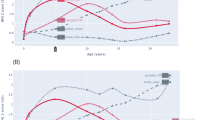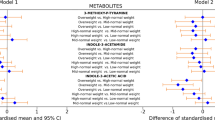Abstract
Background
Obesity in childhood is associated with metabolic dysfunction, adverse subclinical cardiovascular phenotypes and adult cardiovascular disease. Longitudinal studies of youth with obesity investigating changes in severity of obesity with metabolomic profiles are sparse. We investigated associations between (i) baseline body mass index (BMI) and follow-up metabolomic profiles; (ii) change in BMI with follow-up metabolomic profiles; and (iii) change in BMI with change in metabolomic profiles (mean interval 5.5 years).
Methods
Participants (n = 98, 52% males) were recruited from the Childhood Overweight Biorepository of Australia study. At baseline and follow-up, BMI and the % >95th BMI-centile (percentage above the age-, and sex-specific 95th BMI-centile) indicate severity of obesity, and nuclear magnetic resonance spectroscopy profiling of 72 metabolites/ratios, log-transformed and scaled to standard deviations (SD), was performed in fasting serum. Fully adjusted linear regression analyses were performed.
Results
Mean (SD) age and % >95th BMI-centile were 10.3 (SD 3.5) years and 134.6% (19.0) at baseline, 15.8 (3.7) years and 130.7% (26.2) at follow-up. Change in BMI over time, but not baseline BMI, was associated with metabolites at follow-up. Each unit (kg/m2) decrease in sex- and age-adjusted BMI was associated with change (SD; 95% CI; p value) in metabolites of: alanine (−0.07; −0.11 to −0.04; p < 0.001), phenylalanine (−0.07; −0.10 to −0.04; p < 0.001), tyrosine (−0.07; −0.10 to −0.04; p < 0.001), glycoprotein acetyls (−0.06; −0.09 to −0.04; p < 0.001), degree of fatty acid unsaturation (0.06; 0.02 to 0.10; p = 0.003), monounsaturated fatty acids (−0.04; −0.07 to −0.01; p = 0.004), ratio of ApoB/ApoA1 (−0.05; −0.07 to −0.02; p = 0.001), VLDL-cholesterol (−0.04; −0.06 to −0.01; p = 0.01), HDL cholesterol (0.05; 0.08 to 0.1; p = 0.01), pyruvate (−0.08; −0.11 to −0.04; p < 0.001), acetoacetate (0.07; 0.02 to 0.11; p = 0.005) and 3-hydroxybuturate (0.07; 0.02 to 0.11; p = 0.01). Results using the % >95th BMI-centile were largely consistent with age- and sex-adjusted BMI measures.
Conclusions
In children and young adults with obesity, decreasing the severity of obesity was associated with changes in metabolomic profiles consistent with lower cardiovascular and metabolic disease risk in adults.
This is a preview of subscription content, access via your institution
Access options
Subscribe to this journal
Receive 12 print issues and online access
$259.00 per year
only $21.58 per issue
Buy this article
- Purchase on Springer Link
- Instant access to full article PDF
Prices may be subject to local taxes which are calculated during checkout



Similar content being viewed by others
Code availability
The computer code used in this study is available upon reasonable request, subject to approval by COBRA data custodians.
References
Skinner AC, Ravanbakht SN, Skelton JA, Perrin EM, Armstrong SC. Prevalence of obesity and severe obesity in US children, 1999–2016. Pediatrics. 2018;141:e20173459.
Iannuzzi A, Licenziati MR, Acampora C, Renis M, Agrusta M, Romano L, et al. Carotid artery stiffness in obese children with the metabolic syndrome. Am J Cardiol. 2006;97:528–31.
Hudson LD, Rapala A, Khan T, Williams B, Viner RM. Evidence for contemporary arterial stiffening in obese children and adolescents using pulse wave velocity: a systematic review and meta-analysis. Atherosclerosis. 2015;241:376–86.
Saner C, Laitinen TT, Nuotio J, Arnup SJ, Harcourt BE, Bekkering S, et al. Modest decrease in severity of obesity in adolescence associates with low arterial stiffness. Atherosclerosis. 2021;335:23–30.
Chung ST, Onuzuruike AU, Magge SN. Cardiometabolic risk in obese children. Ann N Y Acad Sci. 2018;1411:166.
Rank M, Siegrist M, Wilks DC, Langhof H, Wolfarth B, Haller B, et al. The cardio-metabolic risk of moderate and severe obesity in children and adolescents. J Pediatr. 2013;163:137–42.
American Diabetes Association. 12. Children and adolescents: standards of medical care in diabetes—2018. Diabetes Care. 2018;41(Suppl 1):S126–S36.
Soininen P, Kangas AJ, Würtz P, Suna T, Ala-Korpela M. Quantitative serum nuclear magnetic resonance metabolomics in cardiovascular epidemiology and genetics. Circ Cardiovasc Genet. 2015;8:192–206.
Delles C, Rankin NJ, Boachie C, McConnachie A, Ford I, Kangas A, et al. Nuclear magnetic resonance‐based metabolomics identifies phenylalanine as a novel predictor of incident heart failure hospitalisation: results from PROSPER and FINRISK 1997. Eur J Heart Fail. 2018;20:663–73.
Akbaraly T, Würtz P, Singh-Manoux A, Shipley MJ, Haapakoski R, Lehto M, et al. Association of circulating metabolites with healthy diet and risk of cardiovascular disease: analysis of two cohort studies. Sci Rep. 2018;8:1–14.
Cirulli ET, Guo L, Swisher CL, Shah N, Huang L, Napier LA, et al. Profound perturbation of the metabolome in obesity is associated with health risk. Cell Metab. 2019;29:488–500.
Weintraub WS, Daniels SR, Burke LE, Franklin BA, Goff DC Jr, Hayman LL, et al. Value of primordial and primary prevention for cardiovascular disease: a policy statement from the American Heart Association. Circulation. 2011;124:967–90.
Saner C, Harcourt BE, Pandey A, Ellul S, McCallum Z, Kao KT, et al. Sex and puberty-related differences in metabolomic profiles associated with adiposity measures in youth with obesity. Metabolomics. 2019;15:75.
Sabin MA, Clemens SL, Saffery R, McCallum Z, Campbell MW, Kiess W, et al. New directions in childhood obesity research: how a comprehensive biorepository will allow better prediction of outcomes. BMC Med Res Methodol. 2010;10:100.
Kuczmarski RJ, Ogden CL, Grummer-Strawn LM, Flegal KM, Guo SS, Wei R, et al. CDC growth charts: United States. Adv. Data. 2000;314:1–27.
Gulati AK, Kaplan DW, Daniels SR. Clinical tracking of severely obese children: a new growth chart. Pediatrics. 2012;130:1136–40.
Cole TJ, Faith MS, Pietrobelli A, Heo M. What is the best measure of adiposity change in growing children: BMI, BMI%, BMI z-score or BMI centile? Euro J Clin Nutr. 2005;59:419–25.
Freedman DS, Butte NF, Taveras EM, Goodman AB, Ogden CL, Blanck HM. The limitations of transforming very high body mass indexes into z-scores among 8.7 million 2-to 4-year-old children. J Pediatr. 2017;188:e1.
Marchall W, Tanner J. Variations in the pattern of pubertal changes in girls and boys. Arch Dis Child. 1969;44:291–303.
Pink B. Socio-Economic Indexes for Areas (SEIFA) 2011. Canberra: Australian Bureau of Statistics; 2013.
Team RC. R: a language and environment for statistical computing. 2013.
Benjamini Y, Hochberg Y. Controlling the false discovery rate: a practical and powerful approach to multiple testing. J R Stat Soc Series B Methodol. 1995;57:289–300.
Bagheri M, Djazayery A, Farzadfar F, Qi L, Yekaninejad MS, Aslibekyan S, et al. Plasma metabolomic profiling of amino acids and polar lipids in Iranian obese adults. Lipids Health Dis. 2019;18:94.
Würtz P, Wang Q, Kangas AJ, Richmond RC, Skarp J, Tiainen M, et al. Metabolic signatures of adiposity in young adults: Mendelian randomization analysis and effects of weight change. PLoS Med. 2014;11:e1001765.
Wahl S, Vogt S, Stuckler F, Krumsiek J, Bartel J, Kacprowski T, et al. Multi-omic signature of body weight change: results from a population-based cohort study. BMC Med. 2015;13:48.
Caleyachetty R, Thomas GN, Toulis KA, Mohammed N, Gokhale KM, Balachandran K, et al. Metabolically healthy obese and incident cardiovascular disease events among 3.5 million men and women. J Am Coll Cardiol. 2017;70:1429–37.
Kim JY, Park JY, Kim OY, Ham BM, Kim H-J, Kwon DY, et al. Metabolic profiling of plasma in overweight/obese and lean men using ultra performance liquid chromatography and Q-TOF mass spectrometry (UPLC− Q-TOF MS). J Proteome Res. 2010;9:4368–75.
Rauschert S, Uhl O, Koletzko B, Hellmuth C. Metabolomic biomarkers for obesity in humans: a short review. Ann Nutr Metab. 2014;64:314–24.
Würtz P, Mäkinen V-P, Soininen P, Kangas AJ, Tukiainen T, Kettunen J, et al. Metabolic signatures of insulin resistance in 7,098 young adults. Diabetes. 2012;61:1372–80.
Wiklund PK, Pekkala S, Autio R, Munukka E, Xu L, Saltevo J, et al. Serum metabolic profiles in overweight and obese women with and without metabolic syndrome. Diabetol Metab Syndr. 2014;6:40.
Arany Z, Neinast M. Branched chain amino acids in metabolic disease. Curr Diabetes Rep. 2018;18:76.
McCormack SE, Shaham O, McCarthy MA, Deik AA, Wang TJ, Gerszten RE, et al. Circulating branched-chain amino acid concentrations are associated with obesity and future insulin resistance in children and adolescents. Pediatr Obes. 2013;8:52–61.
Tobias DK, Lawler PR, Harada PH, Demler OV, Ridker PM, Manson JE, et al. Circulating branched-chain amino acids and incident cardiovascular disease in a prospective cohort of US women. Circ Genom Precis Med. 2018;11:e002157.
Shah SH, Bain JR, Muehlbauer MJ, Stevens RD, Crosslin DR, Haynes C, et al. Association of a peripheral blood metabolic profile with coronary artery disease and risk of subsequent cardiovascular events. Circ Cardiovasc Genet. 2010;3:207–14.
Akinkuolie AO, Buring JE, Ridker PM, Mora S. A novel protein glycan biomarker and future cardiovascular disease events. J Am Heart Assoc. 2014;3:e001221.
Lawler PR, Akinkuolie AO, Chandler PD, Moorthy MV, Vandenburgh MJ, Schaumberg DA, et al. Circulating N-linked glycoprotein acetyls and longitudinal mortality risk. Circ Res. 2016;118:1106–15.
Tibuakuu M, Fashanu OE, Zhao D, Otvos JD, Brown TT, Haberlen SA, et al. GlycA, a novel inflammatory marker, is associated with subclinical coronary disease. Aids. 2019;33:547–57.
Joshi AA, Lerman JB, Aberra TM, Afshar M, Teague HL, Rodante JA, et al. GlycA is a novel biomarker of inflammation and subclinical cardiovascular disease in psoriasis. Circ Res. 2016;119:1242–53.
Berg AH, Scherer PE. Adipose tissue, inflammation, and cardiovascular disease. Circ Res. 2005;96:939–49.
Ridker PM, Cushman M, Stampfer MJ, Tracy RP, Hennekens CH. Inflammation, aspirin, and the risk of cardiovascular disease in apparently healthy men. N Engl J Med. 1997;336:973–9.
Wang Z, Nakayama T. Inflammation, a link between obesity and cardiovascular disease. Mediators Inflamm. 2010;2010:535918.
Gillman MW, Ludwig DS. How early should obesity prevention start?. N Engl J Med. 2013;369:2173–5.
Sun J, Xi B, Yang L, Zhao M, Juonala M, Magnussen CG. Weight change from childhood to adulthood and cardiovascular risk factors and outcomes in adulthood: a systematic review of the literature. Obes Rev. 2021;22:e13138.
Ward ZJ, Long MW, Resch SC, Giles CM, Cradock AL, Gortmaker SL. Simulation of growth trajectories of childhood obesity into adulthood. N Engl J Med. 2017;377:2145–53.
Bakar MHA, Sarmidi MR, Cheng K-K, Khan AA, Suan CL, Huri HZ, et al. Metabolomics—the complementary field in systems biology: a review on obesity and type 2 diabetes. Mol Biosyst. 2015;11:1742–74.
Acknowledgements
The authors would like to thank the COBRA participants and their families.
Funding
Research at the Murdoch Children’s Research Institute is supported in part by the Victorian Government Operational Infrastructure Support Program. DB is supported by an NHMRC Investigator Grant (1175744). SB is supported by the Dutch Scientific Organisation (NWO, Rubicon grant no. 452173113).
Author information
Authors and Affiliations
Contributions
TM, DB and CS conceptualised and developed the study. MS set up the cohort, supervised the data collection and critically revised the manuscript. BEH, ZM and K-TK collected data and critically revised the manuscript. TM undertook statistical analysis. CGM assisted with the statistical analysis plan and provided support in interpreting the results. TM, DB and CS drafted the manuscript. JN, TTL, SB, MJ and RS revised the manuscript for important intellectual content. All authors provided expert advice and critical review of the manuscript and approved the final version.
Corresponding author
Ethics declarations
Competing interests
The authors declare no competing interests.
Additional information
Publisher’s note Springer Nature remains neutral with regard to jurisdictional claims in published maps and institutional affiliations.
Supplementary information
Rights and permissions
About this article
Cite this article
Mansell, T., Magnussen, C.G., Nuotio, J. et al. Decreasing severity of obesity from early to late adolescence and young adulthood associates with longitudinal metabolomic changes implicated in lower cardiometabolic disease risk. Int J Obes 46, 646–654 (2022). https://doi.org/10.1038/s41366-021-01034-7
Received:
Revised:
Accepted:
Published:
Issue Date:
DOI: https://doi.org/10.1038/s41366-021-01034-7



